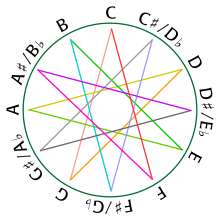Twelfth root of two
The twelfth root of two or (or equivalently ) is an algebraic irrational number. It is most important in Western music theory, where it represents the frequency ratio (musical interval) of a semitone (![]()
Numerical value
The twelfth root of two to 20 significant figures is 1.0594630943592952646.[2] Fraction approximations in increasing order of accuracy are 18/17, 196/185, and 18904/17843.
As of December 2013, its numerical value has been computed to at least twenty billion decimal digits.[3]
The equal-tempered chromatic scale
A musical interval is a ratio of frequencies and the equal-tempered chromatic scale divides the octave (which has a ratio of 2:1) into twelve parts.
Applying this value successively to the tones of a chromatic scale, starting from A above middle C (known as A4) with a frequency of 440 Hz, produces the following sequence of pitches:
| Note | Standard interval name(s) relating to A 440 |
Frequency (Hz) |
Multiplier | Coefficient (to six places) |
Just intonation ratio |
|---|---|---|---|---|---|
| A | Unison | 440.00 | 20⁄12 | 1.000000 | 1 |
| A♯/B♭ | Minor second/Half step/Semitone | 466.16 | 21⁄12 | 1.059463 | ≈ 16⁄15 |
| B | Major second/Full step/Whole tone | 493.88 | 22⁄12 | 1.122462 | ≈ 9⁄8 |
| C | Minor third | 523.25 | 23⁄12 | 1.189207 | ≈ 6⁄5 |
| C♯/D♭ | Major third | 554.37 | 24⁄12 | 1.259921 | ≈ 5⁄4 |
| D | Perfect fourth | 587.33 | 25⁄12 | 1.334839 | ≈ 4⁄3 |
| D♯/E♭ | Augmented fourth/Diminished fifth/Tritone | 622.25 | 26⁄12 | 1.414213 | ≈ 7⁄5 |
| E | Perfect fifth | 659.26 | 27⁄12 | 1.498307 | ≈ 3⁄2 |
| F | Minor sixth | 698.46 | 28⁄12 | 1.587401 | ≈ 8⁄5 |
| F♯/G♭ | Major sixth | 739.99 | 29⁄12 | 1.681792 | ≈ 5⁄3 |
| G | Minor seventh | 783.99 | 210⁄12 | 1.781797 | ≈ 9⁄5 |
| G♯/A♭ | Major seventh | 830.61 | 211⁄12 | 1.887748 | ≈ 15⁄8 |
| A | Octave | 880.00 | 212⁄12 | 2.000000 | 2 |
The final A (A5: 880 Hz) is exactly twice the frequency of the lower A (A4: 440 Hz), that is, one octave higher.
The just or Pythagorean perfect fifth is 3/2, and the difference between the equal tempered perfect fifth and the just is a grad, the twelfth root of the Pythagorean comma (12√531441/524288). The equal tempered Bohlen–Pierce scale uses the interval of the thirteenth root of three (13√3). Stockhausen's Studie II (1954) makes use of the twenty-fifth root of five (25√5), a compound major third divided into 5x5 parts. The delta scale is based on ≈50√3/2, the gamma scale is based on ≈20√3/2, the beta scale is based on ≈11√3/2, and the alpha scale is based on ≈9√3/2.
Pitch adjustment


Since the frequency ratio of a semitone is close to 106% (), increasing or decreasing the playback speed of a recording by 6% will shift the pitch up or down by about one semitone, or "half-step". Upscale reel-to-reel magnetic tape recorders typically have pitch adjustments of up to ±6%, generally used to match the playback or recording pitch to other music sources having slightly different tunings (or possibly recorded on equipment that was not running at quite the right speed). Modern recording studios utilize digital pitch shifting to achieve similar results, ranging from cents up to several half-steps (note that reel-to-reel adjustments also affect the tempo of the recorded sound, while digital shifting does not).
DJ turntables can have an adjustment up to ±20%, but this is more often used for beat synchronization between songs than for pitch adjustment, which is mostly useful only in transitions between beatless and ambient parts. For beatmatching music of high melodic content the DJ would primarily try to look for songs that sound harmonic together when set to equal tempo.
History
Historically this number was proposed for the first time in relationship to musical tuning in 1580 (drafted, rewritten 1610) by Simon Stevin.[4] In 1581 Italian musician Vincenzo Galilei may be the first European to suggest twelve-tone equal temperament.[1] The twelfth root of two was first calculated in 1584 by the Chinese mathematician and musician Zhu Zaiyu using an abacus to reach twenty four decimal places accurately,[1] calculated circa 1605 by Flemish mathematician Simon Stevin,[1] in 1636 by the French mathematician Marin Mersenne and in 1691 by German musician Andreas Werckmeister.[5]
See also
Notes
- "The smallest interval in an equal-tempered scale is the ratio , so p√n, where the ratio r divides the ratio p ( in an octave) into n equal parts."[1]
References
- Joseph, George Gheverghese (2010). The Crest of the Peacock: Non-European Roots of Mathematics, p.294-5. Third edition. Princeton. ISBN 9781400836369.
- Sloane, N. J. A. (ed.). "Sequence A010774 (Decimal expansion of 12th root of 2)". The On-Line Encyclopedia of Integer Sequences. OEIS Foundation.
- Komsta, Łukasz. "Computations page". Komsta.net. Retrieved 23 December 2016.
- Christensen, Thomas (2002), The Cambridge History of Western Music Theory, p. 205, ISBN 978-0521686983
- Goodrich, L. Carrington (2013). A Short History of the Chinese People, [unpaginated]. Courier. ISBN 9780486169231. Cites: Chu Tsai-yü (1584). New Remarks on the Study of Resonant Tubes.
Further reading
- Barbour, J. M. (1933). "A Sixteenth Century Chinese Approximation for π". American Mathematical Monthly. 40 (2): 69–73. doi:10.2307/2300937. JSTOR 2300937.
- Ellis, Alexander; Helmholtz, Hermann (1954). On the Sensations of Tone. Dover Publications. ISBN 0-486-60753-4.
- Partch, Harry (1974). Genesis of a Music. Da Capo Press. ISBN 0-306-80106-X.
